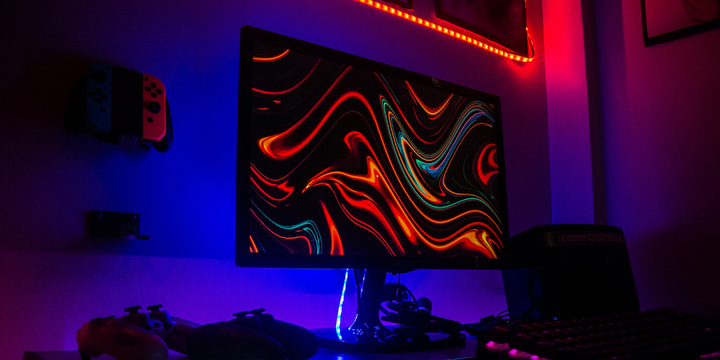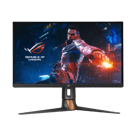Is 1440p the Future for Competitive Gaming?

For the longest time, 1080p (1920×1080) has been the standard resolution for competitive gaming, but a rise in computing power and recent research indicates that competitive gaming at 1440p might be the next standard. In this article, we explore how and why 1920×1080 has become the standard, and why 1440p might take over in the (near) future.
1920×1080 – the standard
Despite higher resolution panels being available at all price ranges for many years now, 1920x1080p has remained the standard resolution for the vast majority of competitive gamers. The reason for this is simple: framerates. Having a high framerate gives you a number of advantages ingame, and professional players simply aren’t ready to give up those advantages in favor of very high resolutions.
Because of the need for high framerates, pro gamers also turn down their graphical settings: eye candy doesn’t matter (and, in some cases, higher graphical options also mean less clarity) if you’re trying to squeeze every ounce of performance out of your PC. Pretty graphics won’t get you anywhere if your opponent can get the jump on you because their PC is performing better, and in the pro scene every little percentage point of performance can make a world of difference.
In games like CS:GO, many pros even take this to the extreme by playing at even lower resolutions. Admittedly, this is partially due to them being used to lower resolutions from the old days, and also because playing at stretched resolutions makes character models appear bigger, in turn making them easier to hit for some (we say ‘for some’ because this isn’t objectively true: the actual hitboxes in the game don’t change, but making them appear bigger can make them seem easier to hit) but it’s still a good example of just how far professionals are willing to go in order to get the edge over their opponents.
1440p – The new standard?
Every year, computers get more and more powerful, and as such there’s going to be a point where PCs are more than powerful enough to run competitive games at competitive (240Hz and 360Hz) framerates. It is true that the advantages of hitting higher framerates don’t end on the display side but it is also true that there are diminishing returns. If you’re gaming at 450 frames per second, getting 50 frames per second more won’t make a very big difference at all. In this theoretical example, it might be best to dedicate that extra computing power to a higher resolution.
A higher resolution means a sharper, more detailed image, and it’s not hard to see how this can come in handy when aiming at targets that are far away. Think of going for a fight from goose to pit on the iconic Dust 2 map. You’re likely strafing, your enemy is strafing, and if you only see a couple of pixels of the enemy’s head sticking out, it can be hard to make out when exactly it’s time to pull the trigger for that one tap headshot.
According to research by NVIDIA (they have also released a video on the subject) gaming at 1440p on a 27″ monitor can give you a 3% performance increase when aiming at smaller targets. This might not sound like much, but if you’re playing at the highest ranks where every tiny mistake is punished this can definitely win you a bunch of fights that you otherwise wouldn’t have won. These percentages can mean the difference between winning and losing a long distance poking battle in Apex, a fight on long A Overpass in CS:GO, …
Concerns might be raised about not being able to run the newest competitive games at 1440p, but if we look at VALORANT, which is without a doubt one of the most successful recently launched competitive games, we see that the developers of that game focused on making a game that runs on a large amount of machines as opposed to going for incredible graphics. Developers of competitive games know that their players prioritize performance over graphics, and they need to ensure that their games run smoothly or risk losing players, so we don’t see any truly popular competitive games going for incredibly high minimum requirements anytime soon. The developers would simply alienate too many players.
Should you switch to 1440p for competitive gaming?
All of the above should be placed in perspective. If you’re barely getting 240 frames per second and switching to 1440p means that you drop down to 170 frames per second then it’s probably not going to be worth it. If you have more than enough headroom, however, and you have the budget for it, it could be worth considering going for a 1440p monitor in the (near) future if you’re someone who is gaming at the highest levels.
It should also be noted that not every monitor is made equal. Plenty of monitors (this goes for all resolutions and screen sizes) aren’t made with gaming in mind, so it’s of no use whatsoever to go for a 1440p monitor that’s focused on content creation and thus has a low response time and subpar motion clarity.
1440p 360Hz gaming monitors (as well as esports-grade 1440p 240Hz monitors with IPS panels that match the response times of TN panels) are slowly starting to be released (see below) but of course these are going to make a large dent in your wallet. There is no such thing as a ‘budget’ 1440p 360Hz gaming monitor (yet) so this is technology that we’d really only recommend to people with enough money (as well as a PC that can run their game of choice at the required framerates) and a desire to compete at the highest levels. If you’re a casual gamer who just wants to play a couple of unranked games every now and then it’s probably not going to be worth it to pay the early adopter fee for this technology.
ASUS ROG Swift PG27AQN
Used by 5 players ()The ASUS PG27AQN is without a doubt the most complete and impressive all-round gaming monitor I’ve ever tested. It has such an impressive array of features and specs that it’s hard not to love it, and the Ultra-fast IPS panel does wonders to bring IPS monitors in line with TN monitors when it comes to response times and motion clarity.
Pros
- Great response times thanks to Ultrafast IPS Technology
- Great picture quality
- 1440p + 360Hz makes for a ultra high tier gaming display
- Basically has a 25″ 1080p monitor built into it in the form of the Esports 25″ mode
Cons
- No motion blur reduction technology present
- Stand has a rather large footprint
- Very expensive
Specs
| Size | 27″ |
|---|---|
| Resolution | 2560×1440 |
| Aspect Ratio | 16:9 |
| Refresh Rate | 360 |
| G-Sync | Yes |
| FreeSync | No |
| Panel Tech | IPS |
Other top tier 1440p esports monitors to consider include the following:
- Acer Predator XB273U (1440p / 360Hz)
- ASUS ROG SWIFT PG279QM (1440p / 240Hz)
- Alienware AW2721D (1440p / 240Hz)
As technology progresses, we will see these panels become more affordable in the future, and given the fact that PCs are only getting more powerful we will probably see 1440p as the standard in a few years’ time. It would be a logical evolution of technology.
So to answer the question in the title: yes, we believe 1440p is the future of competitive gaming, but as with any new (1440p isn’t new, but 1440p 240/360Hz gaming-grade monitors are) technology it’s not something that we recommend to the regular consumer as of yet due to the high early adopter prices. For now, this is something that only gamers with deep wallets and/or a desire (and the skills) to play at the highest levels, but these are exciting times indeed for gaming monitors.










Would a 4070ti and an i7 14th gen cpu (when it comes out) be enough for 1440p 360 fps in fortnite stacked tournament endgames?
That’s a very strong setup so it should be enough to push a ton of frames. A lot depends on your graphical settings (and the state of the game) of course, so no guarantees, but that does sound like a great option.